Annual Events
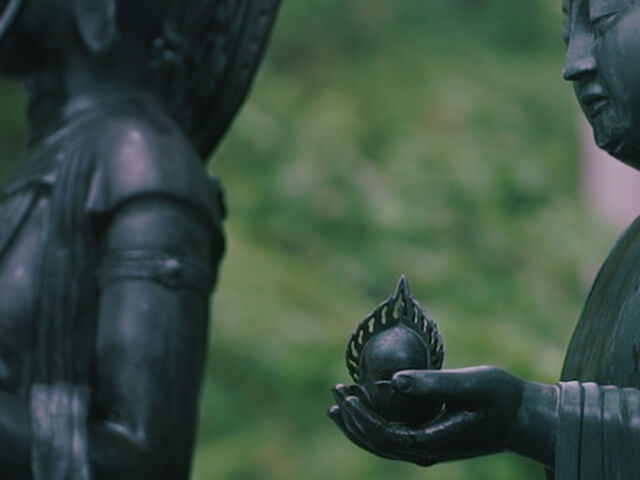
Events Explained
Note that events that correspond to the old lunisolar calendar are now held on Gregorian calendar dates.
1月
January
-
1st-3rd 9:00 amShusho-e
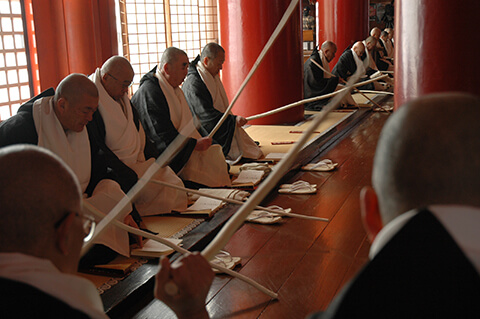
1st-3rd, Garan Kondo (Golden Hall), Okunoin Torodo (Lantern Hall)/ 5th, Garan Oto (Great Pagoda), always from 9:00 am
Originally The New Year is an event that welcomes old god (Toshigami ) responsible for hojo (fertility) of the year, is an alias for January. Currently, for the 3 days from January 1-3 are Sanganichi (first 3 days of the New Year), until January 7th is Matsunouchi or Matsunanoka (New Year’s Week), and this period is referred to as Shogatsu (New Year’s Month). This event is called the Shushoi-e for shu (discipline) and sho (truth). Originally, by doing sange (repentance), one prayed for no disaster, a rich harvest, and national tranquility, and this was called Keka. With the Omizutori (water-drawing ceremony), this is similar with the Todaiji Shuni-e. Furthermore, as the Shusho-e held at Kondo is exoteric Buddhist, and the Shusho-e held at Oto is Mikkyou Buddhist, there are a couple of differences. At the Oto Shusho-e, the final stage of a Buddhist mass lasting 2 hours is the hitting of the ground with the Go Otsue (staff), praying for one year of good health. Those visiting the temple will receive omamori amulets and fukuzue in order of arrival.
-
17 9:00 amMemorial Service for the victims of the Great Earthquake
January 17, 9:00 am, Okunoin, In front of the Memorial for the victims of the great Hanshin-awaji earthquake
To memorialize the victims of the “Great Hanshin-Awaji Earthquake” which attacked the Hanshin-Awaji district in 1995, a monument was erected in 1996, and a register of names of victims was dedicated. Since, at the Irei monument in Okunoin (about 400 meters straight ahead from the entrance of the middle bridge) a Buddhist mass of mourning is held for the victims.
2月
February
-
3rd 1:00 pmSetsubun-e
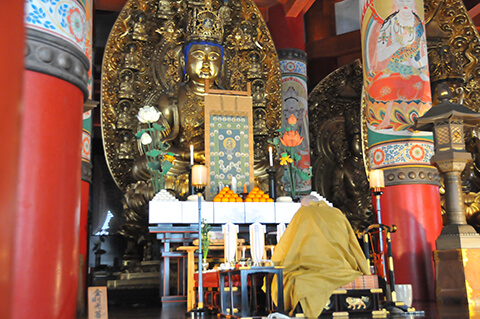
February 3, 1:00 pm, Garan Daito Pagoda
At the Daito shrine, observing the stars and mandala, a holiday for the end of winter is held. Each person, by celebrating the Ursa Major, constellations of the zodiac, and and nine-day constellations of the 28 Chinese mansions, prays for riddance from bad fortune and good fortune.
-
14-15 11:00 pmJoraku-e
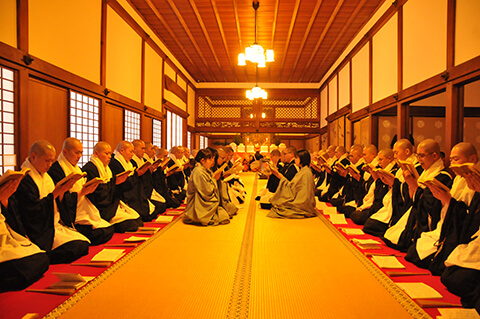
February 14-15, 11:00 pm, Kongobuji Temple Ohiroma
It is also called, “Nehan-e” Every year at Kongobuji Temple Ohiroma, in a Buddhist mass to remember Shakyamuni’s entering in Nirvana. On the day before the Nehan-e, on February 14, starting from the bell at Daito at 11:00 pm, it is held until about noon of the following day, the 15th.
Focused on a ceremony that is accompanied by a beautiful harmony, followers adoring the Buddha have meetings to mourn, and discuss the blessing to have had been taught precious teachings, have a meeting to recite the adoration of the Buddha from far away, of which can all be divided into four scenes addressing the reverence for the Buddha’s ashes.
3月
March
-
21 9:00 amShomieku
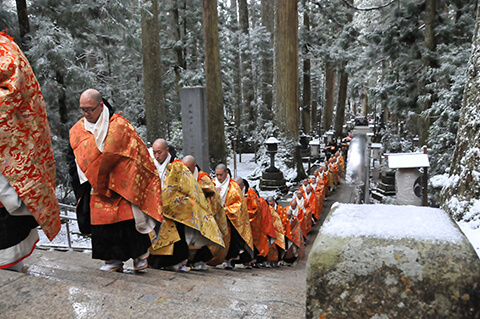
March 21, 9:00 pm, Okunoin-Danjogaran, Mikage-do temple
March 21 is the day of the Daishi’s Gonyujo (Entrance into Nirvana). At Koyasan, on March 21st of the Lunar Year is called Mieku, and the chief priests of the whole mountain pay their gratitude to Daishi. On this day, as a sacrifice for Daishi, the officiating monk for the major annual masses at Koyasan is regarded for service in an extremely brilliant Buddhist mass attended by a great number of followers. It is said that Mieku was started by the a wealthy man (in fact the most eminent) of the time, Kangen Sojo on March 21 of the 76th year since the Daishi passed into nirvana, Engi 10 (910), at the Kanjoin shrine in the Kyoto Toji Temple. At Koyasan, it was later than that, on March 21 of Kyuuan 4 (1148) when the secrets of both the vajra and Garbhadhatu were prayed for and they dedicated their gratitude.
Currently, as a shrine for the Gyoi, the Gyoi will be transferred from the famous Hoki-in to Kongobuji Temple along with followers in a karabitsu chest. At Kongobuji, beginning with the director of the temple, a ritual called Shigyodai will be performed. the Gyoi taken to Kongobuji will be placed on a jokomo mat before the jibutsu (a room in a temple holding Buddhist mortuary tablets or celebrating the Buddha) and the lid will be opened, and the Gohoraku (the vertical sutra of the Buddha) will be recited. Continuing, the director will will confirm the contents to an inventory, and immediately face with the shrine, face Okunoin with the followers. When they arrive at Okunoin, the karabitsu will be placed before the Torodo, and immediately the director performs prayers for the deceased.
Furthermore, from 9:00, the performance will be continued with “Shomieku,” The honored gyoi will again with the followers, advance to the Gyoido. Then, the gyoi that arrive at Gyoido will be enshrined inside (the most interior portion of the Gorido), and the memorial will continue for a year. This gyoi will be worn during the next year’s Hoin Gobo.
-
For 3 days, beginning the day before the Chinese Spring
1:00 pmHigan-e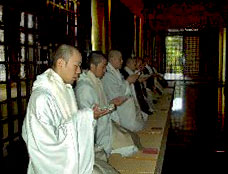
For 3 days, beginning the day before the Chinese Spring and Autumn equinox, 1:00 pm, Garan Kondo
For the service of the equinox, for 3 days in March in spring and September in autumn, at Kondo this event is held to erase sins. Originally, it was held at Miedo, but it was changed to Kondo in Choukyuu 5 (1044).
4月
April
-
Lunar March 21Kyushomieku
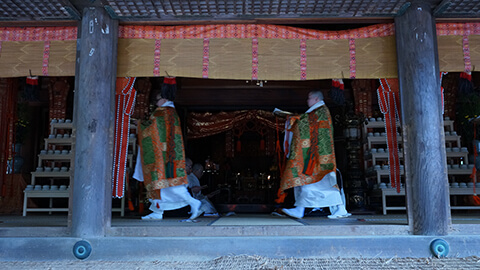
Lunar March 21, Garan Miedo
To celebrate the death of Daishi, on the day of March 21 on the lunar calendar, a ceremony called “Kyushomieku” is performed. On the evening before, Otaiya, a call to worship is done with many people, and the entire temple is covered with flowers and candles. From 6:00 pm, around the songs and dance for the Buddha are done around the Garan Miedo, and at 8:00 pm Otaiya Ho-e is conducted. After that, followers, who may enter the Miedo only once per year, honor Daishi and various teachers.
Also, on that day, from 9:00 am, Mieku no Ho-e will be held at the Okunoin Torodo, and from 1:00, the Mieku no Ho-e will be held at the Miedo. The chief priest of the town, together with the Hoin Gobo, will take the road from Kongobuji Temple. The Hoin Gobo will ride in a palanquin like at the time time of Kechien Kanjo. In both masses, the Hoin Gobo will attend, will conduct an offering of Urasenke tea and flowers from Koyasan to the gods and at the temple and Kage-do, making it a Buddhist mass very worth seeing. We recommend this as a fitting visit to the temple
When visiting Miedo at the time of Otaiya, worshippers, please get numbered tickets the main tent across from Meido. -
8 9:00 amBussho-e
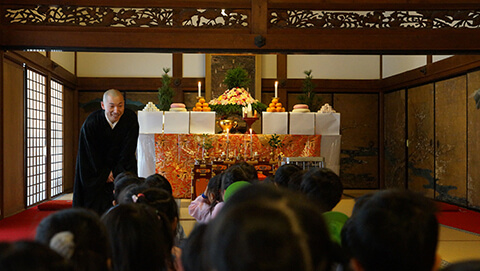
April 8, 9:00 am, Kongobuji Ohiroma
Bussho-e is a Buddhist mass, like Hanamatsuri (Flower Festival), celebrating the birth of Shakyamuni. At the mass, a person called the Shiki-shi (ceremony leader) will give a respectful reading of the “Bussho-e Koshiki.” That has become something like a story, with praise being given in certain sections in this recital starting from the birth of Shakyamuni until his death. Also, in the Hanamido, adorned with cedar leafs, a figure of the Shakyamuni at his birth is enshrined. There is a ritual called “Kanboku.” The chief priest who attended on this day performs a memorial service by sprinkling “Amacha (hydrangea tea)” over the head of the Shakyamuni, as a way to bring the mass to a close.
Also, on the day of the mass, worshippers are treated to amacha by the Koyasan Temple Women’s Association.
-
10 9:00 amDaimandara-ku
April 10, 9:00 am, Garan Kondo
This is one of the oldest and important masses at Koyasan. This mass is a service for both, the Kongo (diamond) and the Taizo (womb realm) mandalas of similar name, and is a service of tremendous gratitude for pious acts towards all living things. It ranks with the “Kechien Kando” in May as one of the most important masses held at Koyasan.
On the day of the mass, the chief priests take a route from the temple Taikaido to the Kondo. Because they are wearing golden stoles called “Noue,” it is a gorgeous procession. Of course, the Hoin Gobo is in attendance on this day.
-
21 9:00 amOkunoin Mando-e
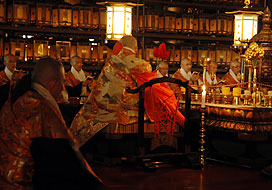
April 21, 9:00 am, Okunoin Torodo(Lantern Hall)
On the day of the mass, the chief priests take a route from the temple Taikaido to the Kondo. Because they are wearing golden stoles called “Noue,” it is a gorgeous procession. Of course, the Hoin Gobo is in attendance on this day.
5月
May
-
3-5Kechien Kanjo
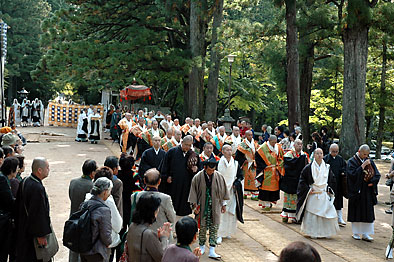
Taizokai: May 3-5, Kongokai: October 1-3, Garan Kondo
“Taizokai Kechien Kanjo on May 3-5, and “Kondokai Kechien Kanjo on October 1-3 will he held at Daigaran and Kondo.
In this ceremony, by throwing a flower into a mandala representing the world of the Buddha, a connection (Kechien) is made with the Buddha (Mikkyou noble teaching), and by pouring water of the Dainichi Nyorai over the head by the Ajari (known as Kanjo), everybody’s souls will be purified and will be guided and opened to the soul and wisdom of the Buddha. At Koyasan, this is a greatly important ritual, along with the previous “Daimandaraku.” We are touched by this sacred opportunity, and pray to receive a rich soul.
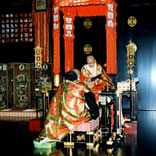
On the opening days in May and October, before the Nyudan, the ceremony of “Teigi Kechien Kanjo Sanmayakai” is held. Please be blessed with the “dharma” for which Mikkyou is grateful. Regardless of being a priest and layman, anyone can make a connection with the various Buddhas of the Kongo and Taizo. Recipients are marked with a symbol and Shingon, and then both eyes are covered. Before the mark, a flower given, and the recipient is shown to the mandala.. Then, by throwing the flower into the mandala, the link is made with the “Butsuren” of the Buddhas of the mandala. This is called “Toukeku Butsu.” Next, the wisdom water of the Nyorai is poured by the Ajari. By doing this, we receive a lighted guideposts to navigate the darkness of worldly desires.
Our possessions are especially unnecessary, but those who have rosaries or stoles, please bring them.
This ceremony is very ancient, with there being records of Daishi performingKongokai in November Kounin 3 (812), Takaoyama in Kyoto, and continuing until December with the Taizo Kanjo.Now, we will discuss the difference between the Kon and Tai Kechien Kanjo. Fundamentally, Kongokai is reverence for Kongokai, and Taizokai is reverence and kechien for the Taizo, but if looked at from a slightly different perspective, Kongokai shows roots in the Kongo Chogyo system , and by expressing the wisdom of the Dainichi Nyorai, and aims at exemplifying everyone’s aspiration for Buddhahood and wisdom of the Buddha. Taizo, having roots in the ideas of the Dainichikyo system, the inherent aspiration for Buddhahood and reason held by everyone being is nurtured by numerous formations, lets the person experience the world. If explained like this, you probably would think, “How difficult that is,” but in returning to the first discussion, let’s make a connection with the Buddhas of Kon and Tai, spring up with “gratitude” in the soul for the Buddha, use that as a clue to the soul, and live our lives to get along with others and living things.
We are ask for an entrance donation of ¥ 5,000 per person.
-
21 9:00 amBoshosokuyo Okunoin Daisegaki-e
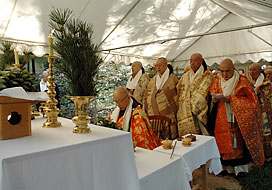
May 21, 9:00 am, Nokotsudo at Okunoin
In Okunoin, there are many cemeteries, and every year, many people are laid to rest. Every year on May 21 we conduct a memorial service for all of the spirits of the deceased. Limited to the chief priests in attendance, by conducting a memorial service for the benefit of suffering spirits, we welcomed into the realm of Daishi, give charities to all suffering souls, and offer Butokku.
First, after the mass for those present at the Torodo, we conduct a memorial service for suffering spirits in the crypt on the left of the mausoleum. We certainly recommend visiting for those laying someone ashes to rest.
-
2nd Sunday 9:00Senbotsusha Irei Ho-e
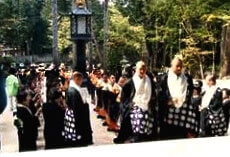
2nd Sunday in May, 9:00 am, Garan Kondo
Senbotsusha Irei Ho-e is a mass in which we console those who lost their lives in the Pacific War and pray for world peace. Lead by the Chigo in procession, departing from the Taikido, while scattering “sange (paper leaflets),the participants make their way to Kondo where the bell for songs in praise of Buddha resounds.
-
Lunar May 1-2Sannoin Summer Prayer
Lunar May 1-2
A yearly Buddhist mass praying for good fortune and adoring the Namikirifudo enshrined in Sannoin.
Essentially, this was a prayer for the four seasons, but currently it has become a “summer prayer.” At this mass, we welcome the Namikiri Acala which includes Buddhas also famous at Koyasan, and at Sannoin, pray for the pleasures of a pious life, peace and tranquility, and a huge harvest.
The Namikiri Fudo involves Daishi at the time that he was returning to Japan from the T’ang Dynasty China in a boat, he came into a storm, and when he prayed with his mind, he saw the Fudo (motionlessness) manifest. With the sword held in hand, the Fudo shook off the roughness of the sea in a single stroke, and miraculously, the waves in that part of the sea subsided, and Kobo was able to sail on safely.
Even currently, it is a Buddhist image normally withheld from the public view, but for those two days only, the public can come and worship it. Going to Sannoin, a “Karabitsu” chest is used, and believers of Namikiri Fudo make the trip with it by hand. Furthermore, this event is performed according to the old Japanese calendar. It is performed on May 1 and 2 on the old Japanese calendar.
-
Lunar May 3 6:00 pmSannoin Rissei
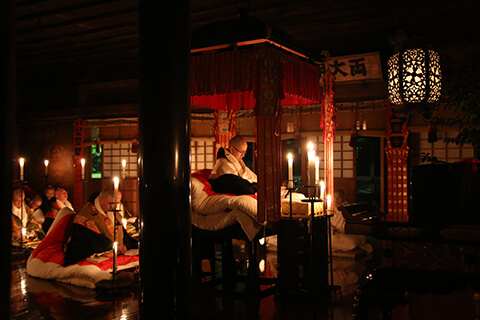
Lunar May 3, 6:00 pm, Garan Sannoin
At Koyasan, since ancient times, it has been customary practice to study various sutras and writings as “Gakudo (Way of Learning). As this Sannoin Rissei is a ceremony related to knowledge handed down. on this day, from the evening until the next day, in a ceremony asking and answering questions related to Mikkyo, and concerning the chief priests of Koyasan, this is a very important mass (or discussion). It roots begin before Sannoin as a ceremony dedicated to Myojin. At one time, there was a time of ruin at Koyasan, and at that time, there was no place to study for monks, and gradually it became neglected. However, Myojin, who oversaw this finally lost patience with this, and decided to return to the world of the gods. Upon hearing this, the priests had great worry, and because of this, immediately sent two monks to the capital, and learned the dialogues of the time, and returned to Koyasan. Suddenly, before Myojin, they opened questions of the Mikkyo. On seeing this, Myojin was very satisfied, and stated, “If this is the case, I will not return home and I shall watch over Koyasan as I did before. On the occasion of this ceremony, I will certainly make it rain and exemplify the act of listening to it.” From then, at the time of this ceremony, it has always seemed like rain. Even today, if it rains at the time of the ceremony, it is stated that “Myojin is here,” and the priests must increasingly revive feelings of gratitude.
This event is also determined by the old Japanese calendar, and as a continuation of the “Natsuki Matsuri (Summer Festival),” it is held on the 3rd of May.
6月
June
-
Lunar June 9-10
10:00 amUchidangi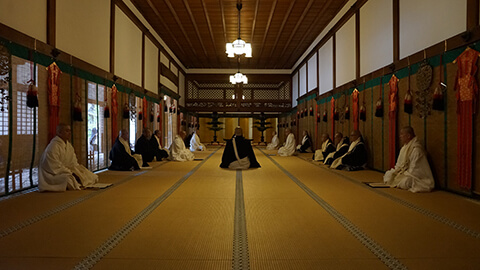
Lunar June 9-10, 10:00 am, Kongobuji Temple Ohiroma
One dialog handed down at Koyasan, is that this continued for 10 days. Originally, it was called “Neri Gakkai,” and the priests served in these discussions, bettered themselves, and studied very hard and built up the priestly rank at Koyasan. There were various unique melodies, and questions were opened to debate. For those interested in Shomyo, we think it is very interesting.
The rank of Koyasan priests has something called “Jogo.” If one does not study the “Gakudo (the study of sutras and writings) of Koyasan, one cannot ascend in rank. The event for moving up is the “Osaishoko,” but questions before that are struggled with in the “Naidangi (private conversation meeting).”
At this mass, Koyasan Study Institution “Kangakukai” Shinshu(freshmen), attend public discussion for the first time, and each of the people cast, intensely practice repeatedly until this day. Originally, a unique melody called “Karongi” was added, and questions were discussed. Also, speech was done in the old style. Currently, it lasts for two days, but in the old times, it lasted for 10 days.
On this day traditional flowers arrangements called “Godanbana (five-story arranging)” are displayed.
-
Lunar June 10-11
6:00 pmMisaisho-ko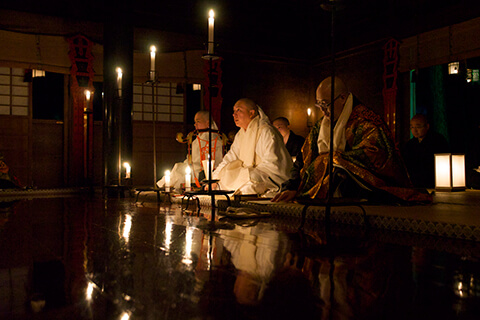
Lunar June 10-11, 6:00 pm, Garan Sannoin
Originally, this was a meeting conducted at the Imperial court to praise the sutras called “Konkomyosaisho Ogo” and pray for national peace. It began in Koyasan in Shouan 3 (1177). At first, of course it praised Konkomyosaisho Ogo, but from Bun’ei 11 (1274) it was changed to a discussion of questions, and by the end of the Meiji era, it came to serve as a lecture meeting lasting five days, with ten seats.
Currently, it has become two days long with four seats, but is still strictly enforced.
Praising the “Konkomyosaisho Ogo,” written by Daishi’s own hand, a mass praying for a protected state, if the “Sayu Gakudo” safely serves the Misaishoko, then an increase in rank called the “Jogo” takes place. In the past, a messenger from the imperial court would attend, and thus this was a very serious mass.
Of course, also at this mass, the Shinshu of “Kangakukai” is in attendance, and is holding a dialog. Sayu Gakudo is sent off by many people at Kongobuji Temple and attends at Sannoin, and lastly, a “Goryoukai (understanding),” to be decided and handed down, and the mass is brought to a close. Also the Hoin Gobo offers his service, and of course, requests the Goryokai, and closes the entire meeting without delay.
-
15 9:00 amShusogotan-e
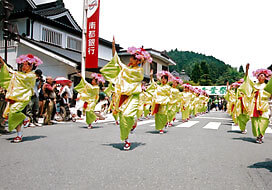
June 15, 9:00 am, Koyasan, Daishi Kyokai Auditorium/ Noon, on Koyasan
This is a celebration of the birthday of Kobo Daishi. This is a festival for the whole mountain in Koyasan. The name of this first comes up written in An’ei 7 (1778), and it is written that at that time, it was conducted at Kondo, In Taisho 4 (1915), Koyasan Daishi Kyokai was completed, and at that time, the venue was changed to the auditorium of the Daishi Kyokai. In the afternoon, the Hanamido transfer is conducted, various dance and taiko organizations from all over Japan attend, and a parade is held on the main street. On this day, as we offer a warm welcome to all people, certainly attend.
On the eve of the day before, there is a night fair, and there is also a “Hoto Retsu (offering procession)” sponsored by the Junior Chamber of Commerce, and the lights of the night festival lights up the streets.
7月
July
-
1st 1:00 pmJunteido Darani-e
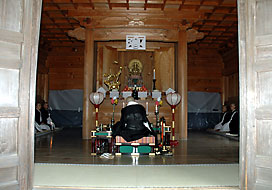
July 1, 1:00 pm, Garan Junteido
This mass, is said to have begun at the time of Bishop Myozan (1021-1106). At the Junteido across from Miedo, the “Sonsho Darani” is recited, and daily offenses are confessed.
-
15 1:00 pmMigoki
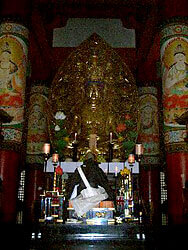
July 15, 1:00 pm, Garan Daito (Great Pagoda)
This is a mass to memorialize the successive generations of emperors. In the beginning, with origins as a ceremony for Empress Jito Kuniki. A memorial service at Kongobuji Temple for Emperor Godaigo has been recorded, but before that, records are not found and it is not clearly understood.
Currently, from 1:00pm, with the officiating monk, the temple administrator switches locations from the Daigaran to the Daito, and prays for the memorial of the bodhis of successive emperors.
8月
August
-
One week, starting August 7
9:00 amFudan-gyo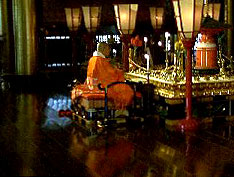
One week, starting August 7, Garan Kondo
Since Kanji 8 (1094), for the sake of Metsusai Shozen, for one week, the inside of Kondo is covered with vertically written scriptures are hung on the wall. Because they are very different chants, those interested in chants find them interesting. At this mass, Bishop Shinzan is honored, and under the Kongo Mandala, the scrolls of Bishop Shinzan and Shakyamuni are hung. The last scripture of the day, is ended in the middle (owarikyo), and is the first script of the next day (Hajimekyo), and thus the weeklong mass continues.
-
11 11:00 amUrabon-e (Feast of Lanterns)
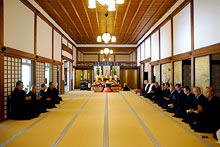
August 11, 11:00 am, Kongobuji Ohiroma (Main Hall)
The Koyasan ancestors names are written and hung, and prayer is done for gratitude and memorial. In Sanskrit, Urabon, seems to come from a translation of “rescue from hanging upside down.” Urabon Kyo in China were a source, in the tale of filial piety in which Mokuren (Maudgalyayana), one of Buddha’s disciples, saw in his mind’s eye, his own mother had fallen into the realm of the hungry ghosts after her death, and he became very weary, and in order to help somehow, he requested from Shakyamuni for help, and finally was able to get help by saying, “Please help my mother with the power of the pious acts done for Shuso in his memorial”
In Japan, this came together with an ancestral spirit festival and became an event to comfort the souls of the ancestors. The festival takes on different forms in different places, but in Koyasan, we have a we also have a unique festival.
At Kongobuji Temple, on August 10, “Butsu Mukae” is done, and on the 11th, “Urabon” is performed. Many decorations are arranged, welcoming various holy spirits.
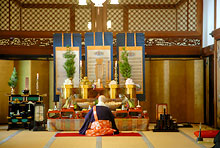
In the center of the Ohiroma, three desks are placed, adorned with Buddhist mortuary tablets. There is an Itatoba stupa which is put into the water basins in the upper right of the photo, and soul names of successive head priests (namely, chief priests of Kongobuji) are written. If you look at the photo on the left, as for Kongobuji Temple, the soul names are being celebrated, but at the Koya Tatchu Temple, many portraits of former teachers are hung. In the temple, with many portraits, even hanging them in difficult. There are many offerings, but certainly, offering “Somen” is becoming customary practice. Also, preparing the Ozen tray, and those details such as arranging flowers for offering has not changed whatsoever.
Departing to perform Butsu Mukae, if you receive the “Kiezu no Hi (Unvanishing Flame)” for use in Mukae, making sure to not lose your flame going and coming from the temple, you first change flames at Kirikotoro. Next, change flames at Aburatoro, and it will stay lit until Obon finishes. After that, those present participate in sutra chanting.
-
13 7:00 pmMandokuyo-e (Rosoku Festival)
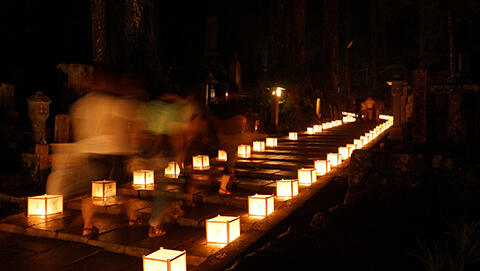
Every year on August 13 at Koyasan, Mandokuyo-e (Rossoku Matsuri) is held. The Rossoku Matsuri is festival memorializing the spirits of the deceased beginning with the ancestors, done by worshippers adorning a sacred road from Ichinobashi to Okunoin with 100,00 candles.
The sight of the lights of 100,000 candles floating above the road approaching is magical, and the line of lights glistening against the pitch black sky is a natural feature of summer at Koyasan. It is a Obon event, where worshippers think of their ancestors as the glow of the lights.
Were are sincerely waiting fora many to visit.
[Mando Kuyo-e]
Dates Tuesday, August 13, 2013 Venue Okunoin Torodo (Lantern Hall) Time From 8:00 pm [Rosoku Matsuri (Candle Festival)]
Dates Tuesday, August 13, 2013 Venue Okunoin Time 7:00-8:30 pm Admission Free Rosoku Matsuri Precautions
- Will be held if there is a light rain
- Candles with be distributed for free at the reception tent at Okunoin Ichinobashi from 7:00 pm.
- Congestion is expected. Trip recommend you refrain from coming by car, so please use public transportation.
- Please refrain from visiting in visitor’s yukata, kimono, or nightwear.
- As you cannot lodge at establishments of the temple, those staying the night, please contact the Koyasan Visitor’s Center/Sightseeing Organization (new window).
- Please be careful, as you cannot park on the second floor of the parking structure, so that a night shop can be set up for the bridge in Okunoin.
Contact
648-0281
Wakayama Prefecture Koya-cho, Ito-gun Oaza Koyasan No. 636
Takano Town Hall
Phone: 0736-56-3000; Fax: 0736-56-4745
9月
September
-
1 1:00 pmMemorial Service for the Victims of the Great Kanto Earthquake
September 1st, 1:00 pm, Memorial for the Victims of the Great Kanto Earthquake in Okunoin
In order to memorialize the victims of the 1923 “Great Kanto earthquake of 1923,” a ceremony is held in Okunoin, at the memorial tower, found approaching the Ichinobashi.
-
11 9:00 amDento Kokushi-ki
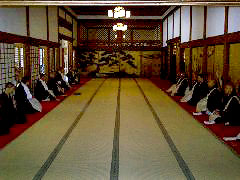
September 11, 9:00 am, Kongobuji Ohiroma (Main Hall)
This is a Buddhist mass celebrating Koyasan second generation Bishop Shinzen, Dento Kokushi. September 11 is the day he passed on to become Bishop Shinzen.
As the nephew of the Daishi, we hold this event to remember Bishop Shinzen as a second generation of Koyasan, using the posthumous name given to him by the Imperial Court.
First, from 8:30 am, Kongobuji Temple staff gather before the Shinzen mausoleum, and after giving up their pleasures, and at the foot of the Ohiroma, perform a mass lead by the current Chief Abbot.
-
For 3 days, beginning the day before the Autumn equinox
1:00 pmHigan-e
For 3 days, beginning the day before the Chinese Spring and Autumn equinox, 1:00 pm, Garan Kondo
For the service of the equinox, for 3 days in March in spring and September in autumn, at Kondo this event is held to erase sins. Originally, it was held at Miedo, but it was changed to Kondo in Choukyuu 5 (1044).
-
23 9:00 amIchiza Doshakaji Ho-e
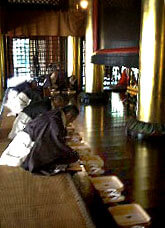
Day of September autumnal equinox, 9:00 am, Garan Kondo (Golden Hall)
Having blessed earth and sand, people pray for the deceased to enter nirvana. On the equinox, by a memorial mass is held not only for the former teachers of Koyasan, but for all deities.
In the middle day of the equinoctial week, At Kondo (Golden Hall), the Ichiza Doshakaji Ho-e is held. This involves blessing earth and sand with the rites by the Mantra of Light, and that sand is scattered for the deceased, and all sin is removed. It was begun to be been able to journey to the realm of the unknown.
Earth and sand are tri-folded into paper, and distributed to many people. While mixing the earth and sand with Shikimi leaves, after the healing from the Mantra of Light, the Hoin Gobo holds a service acting as the Daishi.
-
23 9:00 amKangaku-e (Private)
There is an event for the students of the monks, called “Kangaku-e.” The students study the fine manners of the monks, all sorts of sutras, and Kobo Daishi’s works, and ask many questions. As this event is usually private, let’s move on shortly.
10月
October
-
1st-3rd 7:00 pmOkuin Mando-e

Together with various prayers in Okunoin, an enormous amount of lanterns are dedicated. Because of this, the hall in front of the Kobo Daishi mausoleum is called the “Torodo (Lantern Hall),” and the vicinity is adorned with a countless number of lights. People gather in great numbers in the town in order to make wishes upon the Mandoe (10,000 Lanterns). There are but few evening events at Koyasan, and the monks, in their gorgeous robes and glittering candles create a elegantly subtle world for us. One more characteristic of this event is that students from the Koyasan Senshu Academy join in as monks performing memorials. For some, it is their first ceremony display, and one can experience the world of “Inori (prayer)” for the youth.
-
1st-3rd 8:00 amKechien Kanjo

Taizokai: May 3-5, Kongokai: October 1-3, Garan Kondo
“Taizokai Kechien Kanjo on May 3-5, and “Kondokai Kechien Kanjo on October 1-3 will he held at Daigaran and Kondo.
In this ceremony, by throwing a flower into a mandala representing the world of the Buddha, a connection (Kechien) is made with the Buddha (Mikkyou noble teaching), and by pouring water of the Dainichi Nyorai over the head by the Ajari (known as Kanjo), everybody’s souls will be purified and will be guided and opened to the soul and wisdom of the Buddha. At Koyasan, this is a greatly important ritual, along with the previous “Daimandaraku.” We are touched by this sacred opportunity, and pray to receive a rich soul.

On the opening days in May and October, before the Nyudan, the ceremony of “Teigi Kechien Kanjo Sanmayakai” is held. Please be blessed with the “dharma” for which Mikkyou is grateful. Regardless of being a priest and layman, anyone can make a connection with the various Buddhas of the Kongo and Taizo. Recipients are marked with a symbol and Shingon, and then both eyes are covered. Before the mark, a flower given, and the recipient is shown to the mandala.. Then, by throwing the flower into the mandala, the link is made with the “Butsuren” of the Buddhas of the mandala. This is called “Toukeku Butsu.” Next, the wisdom water of the Nyorai is poured by the Ajari. By doing this, we receive a lighted guideposts to navigate the darkness of worldly desires.
Our possessions are especially unnecessary, but those who have rosaries or stoles, please bring them.
This ceremony is very ancient, with there being records of Daishi performingKongokai in November Kounin 3 (812), Takaoyama in Kyoto, and continuing until December with the Taizo Kanjo.Now, we will discuss the difference between the Kon and Tai Kechien Kanjo. Fundamentally, Kongokai is reverence for Kongokai, and Taizokai is reverence and kechien for the Taizo, but if looked at from a slightly different perspective, Kongokai shows roots in the Kongo Chogyo system , and by expressing the wisdom of the Dainichi Nyorai, and aims at exemplifying everyone’s aspiration for Buddhahood and wisdom of the Buddha. Taizo, having roots in the ideas of the Dainichikyo system, the inherent aspiration for Buddhahood and reason held by everyone being is nurtured by numerous formations, lets the person experience the world. If explained like this, you probably would think, “How difficult that is,” but in returning to the first discussion, let’s make a connection with the Buddhas of Kon and Tai, spring up with “gratitude” in the soul for the Buddha, use that as a clue to the soul, and live our lives to get along with others and living things.
We are ask for an entrance donation of ¥ 5,000 per person.
-
16 12:30 pmMyo Jinja Shuki Taisai
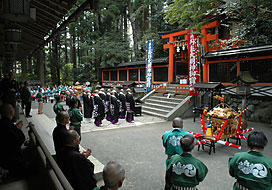
October 16, 12:30 pm, Garan Myo Jinja
This grand festival celebrates the Koya Myojin, the lords of Koyasan. After a memorial for the Myojin, a portable shrine made by middle schoolers is paraded through the town. There are also rice cakes, and many people come to pay homage.
-
27 9:00 amShigo Hosan-e
October 27, 9:00 am, Okunoin Torodo (Lantern Hall)
This ceremony is held in order to celebrate the giving of the posthumous name “Kobo Daishi” by Emperor Daigo on October 27, Engi 21 (921), and its origins are surprisingly new. It was created as an opportunity to have a mass to celebrate the founding of the temple, in Taisho 4 (1915). There is a final ceremony in which Hoin Gobo plays the role of officiating monk, a post which is held until February 22 of the following year, and the next Hoin Gobo is given his post.
